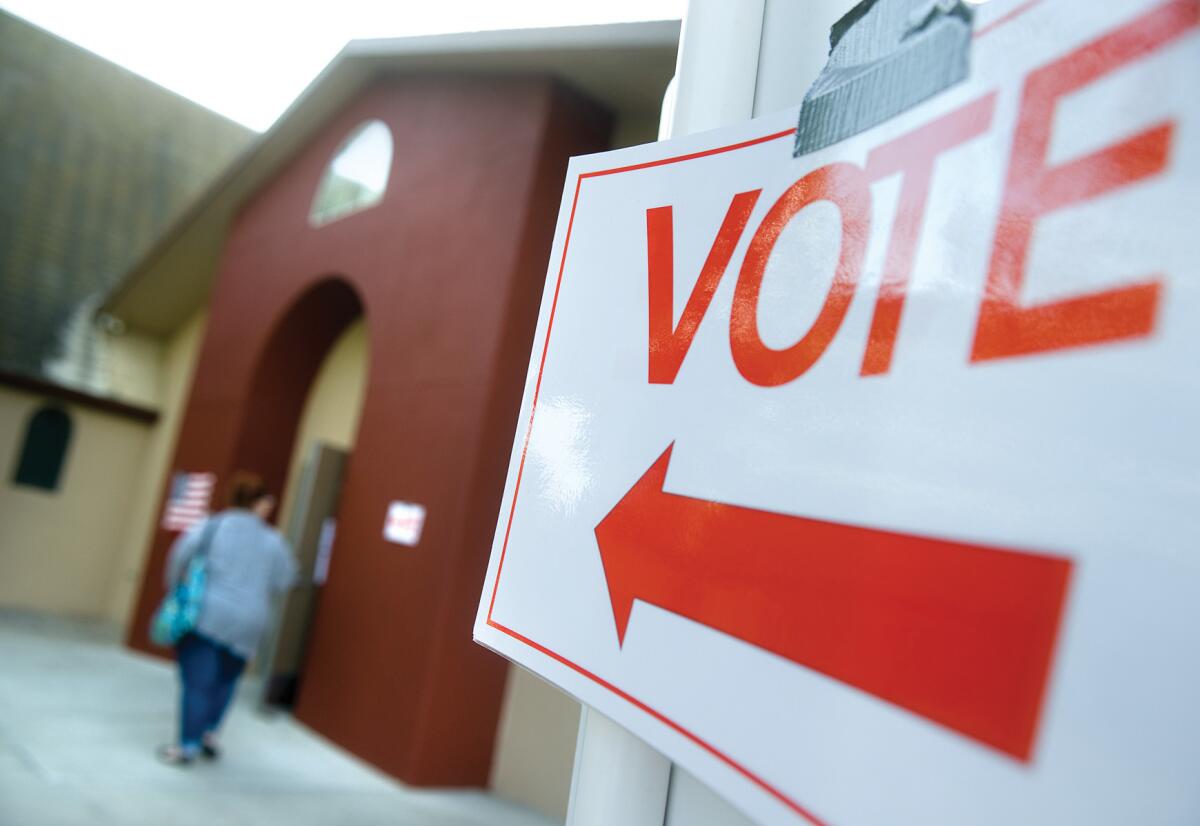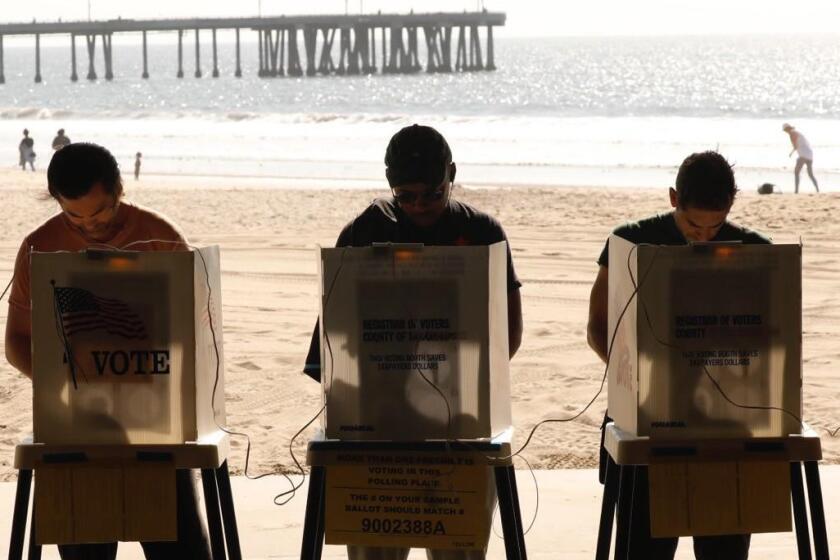Winning California’s Democratic presidential primary isn’t as simple as it sounds

- Share via
SACRAMENTO — Voters in California, like others across the country, have long assumed that only one candidate can win an election. And in most cases, they’re right.
But most presidential primaries work differently — a fact obscured in years past when the race was all but over by the time Californians cast ballots. On March 3, the Democratic presidential campaign will be far from over and the arcane rules for winning in the Golden State will come into play.
How do I vote? Will I get a ballot in the mail? A new procedure will change how some Californians cast ballots. Here’s how to vote in the California primary election.
There are 54 Democratic primaries in California
California will send 494 delegates to the Democratic National Convention in Milwaukee this July. Most of them — 271 delegates — will represent one of the state’s 53 congressional districts.
In essence, the March 3 primary is made up of one statewide election and 53 district-level elections. Candidates will be awarded delegates based on how they do in each of these distinct contests, and the remaining delegates will be divided by the top statewide vote-getters.
Not all of these 54 races will award the same number of delegates. The statewide results decide who wins 90 of California’s “at-large” convention delegates, the single largest subset, as well as 54 delegates representing party leaders and elected officials. In the individual congressional districts, the Democratic Party uses a formula that takes into account population and voting data from the last two presidential elections. No congressional district will award more than seven delegates to the Democratic convention or fewer than four delegates.
Delegates are (sort of) divvied up by vote totals
Here’s where things get complicated, because a Democratic candidate for president can win votes in one of California’s congressional districts and still not be awarded any delegates.
The key in each of these micro-primaries is that a candidate must win at least 15% of the votes cast to walk away with convention delegates. End up with less than 15% of the vote in either a congressional district or the statewide primary, and the candidate gets nothing. In fact, those votes are completely cast aside: The unlucky candidates are crossed off the list and the vote percentages are recalculated.
In other words, if three candidates split 50% of a district’s raw vote — with 19%, 16% and 15% of the ballots cast, for example — all other candidates and totals are discarded. The process then starts over and each candidate’s share of what’s known as the “qualified” votes is calculated.
The simplest way to describe it is to imagine a district where 100 voters cast ballots. After the initial review, only 50 of those ballots — 19 cast for the first-place candidate, 16 for the second-place candidate, 15 for the one in third place — are used to award delegates.
Of the qualified votes, the first-place candidate received 19 of 50 (38%). The second-place candidate received 16 of 50 votes (32%). And the third-place candidate received 15 of 50 votes (30%).
These percentages are now used to award delegates to each of the three candidates.
And then there are a few delegates that won’t come into play unless the convention fails to pick a nominee on the first round of balloting. Seventy-nine California Democrats, including Gov. Gavin Newsom and those in the state’s congressional delegation, are considered “unpledged” delegates to the convention. Their preferences have the potential to be game changers, particularly because they are free to support anyone — even someone who did poorly in the California primary on March 3.
Rounding off for the final delegate total
In the hypothetical district mentioned above, three candidates will receive delegates. Let’s assume that the district is in one of California’s bigger cities and voted strongly for then-President Obama in 2012 and Hillary Clinton in 2016 — and therefore will send seven delegates to the Democratic National Convention.
The first-place candidate received 38% of the qualified primary vote. Multiply that by the total delegates available and the result is 2.66 delegates, which would be rounded up to 3.
The second-place candidate received 32% of the qualified primary vote, which translates into 2.24 delegates — rounded down to 2.
And the third-place candidate received 30% of the qualified primary vote, which results in 2 delegates.
The same system applies for delegates awarded to those who do well in the statewide vote total. There are 144 delegate seats awarded in this contest, some of which will be taken by state party leaders and elected officials. Only candidates receiving 15% or more of all California Democratic primary votes will receive a portion of these delegates.
The results might not always seem logical — or fair
The strict 15% threshold might seem easy to support in theory but much harder to defend in practice — particularly because there’s a very good chance that three or more Democrats will be strong contenders once the polls close across California at 8 p.m. on March 3. There’s likely to be very little difference in support at the congressional level between candidates receiving 13% and 15% of the vote, but a huge difference when it becomes clear one of those contenders will come up empty-handed. On the other hand, it’s possible that a Democrat could be considered by national political watchers as having been shut out of the California primary based on statewide returns — only to have actually been awarded a smattering of delegates from congressional districts spread across the state.
Delegate totals may not be known until April
Perhaps the hardest thing for everyone to accept is that the complicated process means that California’s Democratic delegates really can’t be awarded until state elections officials finalize the vote totals on April 2. Even a fraction of a percentage point in ballots could shift a candidate from winning a few delegates to none. In addition, official election returns aren’t reported by congressional districts until the tally is complete — which could potentially leave no impartial voice to counter the perception peddled by a candidate’s supporters or opponents in the first few days and weeks after the California primary.
More to Read
Get the L.A. Times Politics newsletter
Deeply reported insights into legislation, politics and policy from Sacramento, Washington and beyond. In your inbox three times per week.
You may occasionally receive promotional content from the Los Angeles Times.












